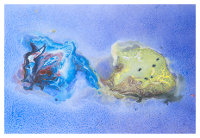Conveners
Parallel II: B7 Light Quarks
- Bernhard Ketzer (Universitaet Bonn (DE))
Kirill Lapidus
(Moscow Physical Engineering Institute (MePhl))
11/09/2014, 14:00
Section B: Light Quarks
The study of Baryonic resonances with strangeness content
produced in hadron-hadron collisions is important
not only to understand the production mechanisms and the
structure of the various resonates, but also as fundamental
input for the modelling and understanding of heavy ion collisions.
New analysis techniques have been employes by the HADES collaboration
to study quantitatively the...
Florian Haas
(Technische Universitaet Muenchen (DE))
11/09/2014, 14:30
Section B: Light Quarks
COMPASS is a multi-purpose fixed-target experiment at the CERN Super Proton Synchrotron aimed at studying the structure and spectrum of hadrons. One main goal is the search for new hadronic states, in particular hybrid mesons and glueballs. Its large acceptance, high resolution, and high-rate capability make the COMPASS experiment an excellent device to study the spectrum of light-quark mesons...
Dmitry Ryabchikov
(Institute for High Energy Physics)
11/09/2014, 15:00
Section B: Light Quarks
The COMPASS experiment, at CERN SPS, has collected the worlds largest statistics
of the reaction pi- p -> pi- pi- pi+ p - more than 5*10^7 events.
The amount and also the quality of this data sample allows for detailed
studies of 3pi partial-wave amplitudes behaviour in 2 dimentions: invariant mass m(3pi) and four momentum transfer t'.
The method of traditional mass-independent PWA...
